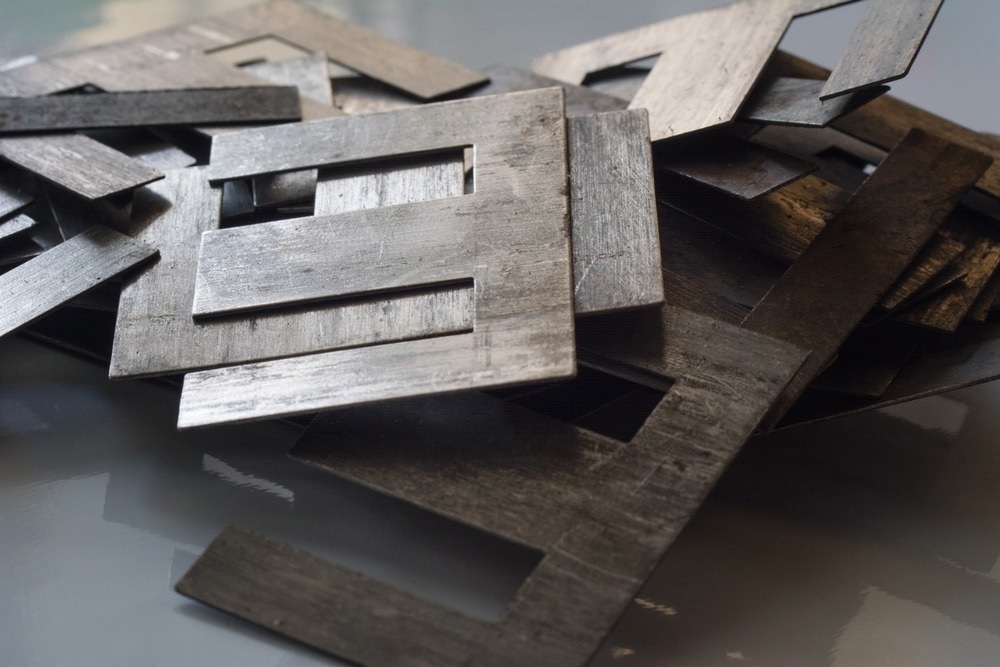 By Taha KhanReviewed by Lexie CornerMar 28 2024
By Taha KhanReviewed by Lexie CornerMar 28 2024This article explores the magnetic properties of steel, its technological applications in sectors like automotive and renewable energy, advancements in production techniques, and future outlooks.

Image Credit: Vlyaks/Shutterstock.com
The History of Magnetic Steel
The origins of magnetic steel can be traced back to the 18th century when scientists began experimenting with iron alloys. In 1820, Hans Christian Oersted's accidental discovery of electromagnetism laid the foundation for further exploration. However, it was not until the late 19th century that technological advancements in steelmaking techniques led to the systematic development of magnetic steel.1, 2
The magnetic behavior of the steel is governed by its composition, microstructure, and processing, resulting in specific properties such as permeability (the ability to conduct magnetic flux), coercivity (resistance to demagnetization), and remanence (residual magnetization after the removal of an external magnetic field).3 These properties are pivotal in determining the suitability of magnetic steel for various applications across several industries, including the power sector, automotive, and construction.
Ferromagnetism in Steel
Ferromagnetism is a special type of magnetism that makes materials such as steel highly susceptible to magnetic attraction. Ferromagnetic materials have atoms with unpaired electrons in their outer shells, which act like mini-magnets, and their spins tend to align in the same direction.
Upon the application of an external magnetic field, the domains within steel orient their spins in the direction of the field, strengthening the magnetic effect and creating a strong attraction to magnets.4
The properties of ferromagnetic steel depend on its alloying elements and heat treatment. Some types of steel, like austenitic stainless steel, have a different microstructure that disrupts the alignment of electron spins, making them non-ferromagnetic.
On the other hand, smaller grain sizes and specific phases can enhance magnetic properties by minimizing energy losses during magnetization and demagnetization.4
Types of Magnetic Steel
Magnetic steel can be broadly categorized into soft magnetic steel and hard magnetic steel, distinguished by their magnetic properties.
Soft magnetic steels do not exhibit magnetic properties when not in a magnetic field. They have low coercivity, sometimes even lower than the earth's magnetic field, and high permeability, making them suitable for various electrical devices, including electrical steels used in transformers to minimize energy losses during power transmission.5
Hard magnetic steels contain higher concentrations of carbon and alloying elements such as cobalt and rare earth metals. These materials retain their magnetism for extended periods with high coercivity and remanence. They find application in scenarios requiring a strong and permanent magnetic field, such as in permanent magnets for electric motors, magnetic recording media, and magnetic clamps.6
Magnetic Characteristics 4140 and 8620 Steel Rods
In a 2009 case study, researchers examined the magnetic properties of induction-hardened 4140 steel and carburized 8620 steel rods. They extracted the differential permeability and saturation magnetization of the rods by analyzing magnetization curves and hysteresis loops.
Results showed that the differential permeability increased with deeper case hardening, especially in the induction-hardened rods. Meanwhile, saturation magnetization decreased with increased case hardening depth for both types of rods.7
Magnetic Steel Applications
Electrical and Electronics Industry
The electrical and electronics industry extensively utilizes magnetic steel in various components. Transformers are used to transfer electrical energy from one circuit to another through magnetic induction.
The core of transformers consists of laminated soft magnetic steel sheets, which channel the magnetic flux generated by the alternating current passing through the primary winding. The high magnetic permeability and low coercivity of soft magnetic steel allow for efficient flux conduction and low energy losses, making it ideal for transformer application. 8
Similarly, inductors utilize soft magnetic steel cores to concentrate and guide magnetic flux, enhancing the inductance of the component. Soft magnetic steel cores also find common use in electromagnets, as they can quickly magnetize and demagnetize in response to changes in the electric current. 9
Electromagnets have a vast range of applications in the electrical and electronics industry, such as relays, solenoid valves, magnetic actuators, magnetic resonance imaging (MRI) machines, and magnetic levitation trains.
Automotive Industry
Electric vehicle (EV) motors, whether permanent magnet synchronous motors, induction motors, or switched reluctance motors, rely on magnetic materials for their operation. For instance, the stator core of these motors typically consists of laminated sheets of soft magnetic steel, which help guide and concentrate the magnetic flux generated by the rotor's permanent magnets.10
Magnetic sensors are also important components in the automotive industry for position, speed, and direction detection. Magnetoresistive sensors and magnetometers are commonly used in vehicles for tasks like measuring wheel speed, detecting the position of the throttle pedal, monitoring the position of the gearbox shift lever, and providing feedback for electronic stability control (ESC) systems.11
Renewable Energy Sector
The applications of magnetic steel in the renewable energy sector are not just limited to EVs—they are also important in renewable energy systems, including wind turbines and hydroelectric power generators. Wind turbine generators typically comprise a rotor, incorporating permanent magnets made from materials like neodymium iron boron and a stator composed of soft magnetic steel laminations.
The permanent magnets in the rotor create a magnetic field, inducing an electrical current in the stator windings as the rotor spins within the wind.12 This process enables the conversion of wind energy into electrical power. A similar process also occurs in hydroelectric power generation, with the main difference being that the turbines are rotated by water instead of air.
Advancements in Magnetic Steel Production
Steel Alloying to Enhance Magnetic Properties
In a 2016 study, researchers investigated the impact of alloying elements on the magnetic properties of various grades of electrical steels to enhance their performance in industrial applications. They focused on the influence of silicon (Si) and aluminum (Al) content on magnetic characteristics.
Their findings highlighted that the addition of Si and Al decreased losses by increasing electrical resistivity and modifying grain size, thereby improving magnetic properties.
The study revealed that electrical steel grades containing 0.5-2.5 wt. % Si and 0.02-1.2 wt. % Al exhibited magnetic induction ranging from 1.6 to 1.7 T and magnetic energy density from 40 to 80 mJ/kg.
These insights hold significance for advancements in steel manufacturing and design processes, aiming to maximize saturation induction and minimize energy losses. 8
Impact of Nanotechnology on Magnetic Performance of Steel
In a 2006 study, researchers selectively induced ferromagnetism in austenitic stainless steel using a nanoindenter, generating micrometer and submicrometer magnetic structures.
This method leverages stress-induced martensitic phase transformation in steel, which can be controlled to create desired magnetic patterns. The induced ferromagnetism was confirmed through various measurements, including magneto-optical Kerr effect and magnetic force microscopy.
The study highlights the potential applications of this microstructuration technique in various fields, including magnetic sensors and recording media.13
Future Outlooks
The significance of magnetic steel, whether in EVs, hydropower stations, or wind turbines, cannot be overstated. Ongoing research in material science and innovations in steel magnetism hold the potential to push the boundaries of magnetic steel even further. This entails exploring novel materials and optimizing existing steel grades to achieve superior magnetic properties, opening doors for further potential industrial applications.
Sustainability concerns will further push the steel industry toward eco-friendly production and recycling practices. Hence, future research endeavors will prioritize the integration of emerging technologies and sustainable methodologies to augment the magnetic properties of steel, thereby contributing to a more sustainable future.
More from AZoM: Exploring the Metallurgy of Superconducting Materials
References and Further Reading
- Coey, JMD., Mazaleyrat, F. (2023). History of magnetism. [Online] HAL. Available at: https://hal.science/hal-04138750/
- Ernie Tretkoff. (2008). July 1820: Oersted & Electromagnetism. [Online] APS Advancing Physics. Available at: https://www.aps.org/publications/apsnews/200807/physicshistory.cfm (Accessed on 20 March 2024).
- BMT/Ideal. Understanding Magnetic Permeability. [Online] BJMT/Ideal. Available at: https://idealmagnetsolutions.com/knowledge-base/magnetic-permeability-table/ (Accessed on 20 March 2024).
- Liu, Y., Liu, K., Wang, W., Fan, L., Li, B., Yang, T. (2022). Study on the inherent magnetism and its relationship with mechanical properties of structural round steel. Scientific Reports. doi.org/10.1038%2Fs41598-022-20718-2
- Che, S. (2023). Soft Magnetic Materials and Their Applications. Materials. doi.org/10.3390%2Fma17010089
- Moosa, I. S. (2014). History and development of permanent magnets. [Online] International Journal For Research and Development in Technology. Available at: https://www.ijrdt.org/upload/71253IJRDTVLIS21-1421041.pdf
- Zhang, C., Bowler, N., Lo, C. (2009). Magnetic characterization of surface-hardened steel. Journal of Magnetism and Magnetic Materials. doi.org/10.1016/j.jmmm.2009.07.065
- Pricop, V., Helerea, E., Calin, M. D. (2016). Influence of alloy elements on magnetic properties of electrical steels. IEEE. doi.org/10.1109/ICATE.2016.7754607
- He, J., Yuan, H., Nie, M., Guo, H., Yu, H., Liu, Z., Sun, R. (2023). Soft magnetic materials for power inductors: State of art and future development. Materials Today Electronics. doi.org/10.1016/j.mtelec.2023.100066
- Lammotor (2023). What Is The Role Of Stator Core Laminations? [Online] Lammotor. Available at: https://lammotor.com/the-role-of-stator-core-laminations/ (Accessed on 20 March 2024).
- MPS (no date). Harnessing Magnetic Position Sensors for the Future of Automotive Innovation: A Comprehensive Exploration of Selection, Application, and Quality Standards. [Online] MPS. Available at: https://www.monolithicpower.com/en/harnessing-magnetic-position-sensors-for-the-future-of-automotive-innovation (Accessed on 20 March 2024).
- Lacal-Arántegui, R. (2015). Materials use in electricity generators in wind turbines–state-of-the-art and future specifications. Journal of Cleaner Production. doi.org/10.1016/j.jclepro.2014.09.047
- Sort, J., Concustell, A., Menéndez, E., Suriñach, S., Baró, M. D., Farran, J., Nogués, J. (2006). Selective generation of local ferromagnetism in austenitic stainless steel using nanoindentation. Applied physics letters. doi.org/10.1063/1.2227827
Disclaimer: The views expressed here are those of the author expressed in their private capacity and do not necessarily represent the views of AZoM.com Limited T/A AZoNetwork the owner and operator of this website. This disclaimer forms part of the Terms and conditions of use of this website.